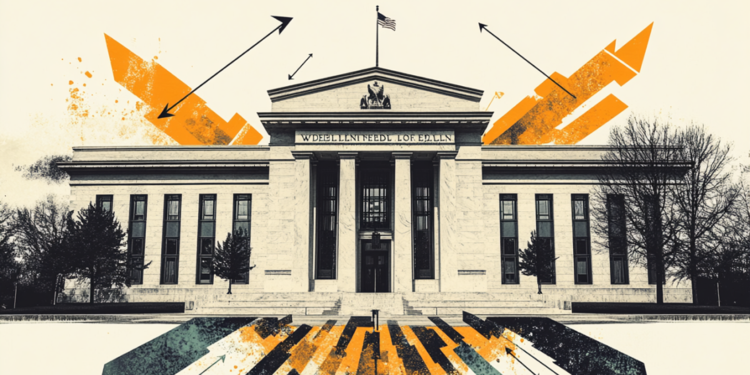- The Dow Jones rises 0.61% on Thursday.
- The Nasdaq 100 loses 0.59%, daily, dragged by Axon Enterprises (Axon).
- The S&P 500 rises 0.05% in the day, after key economic data of the USA.
- Donald Trump reiterated that 25% tariffs to Mexico and Canada will take effect on March 4.
The Dow Jones marked a minimum of the day in 43,342, finding aggressive buyers who took the index to a maximum of four days in 43,881.
The Dow Jones industrial average began operating at 43,534, while the Nasdaq 100 technological index began the contributions in 21,028. The S&P 500 opened in 5,969, staying within the range of the previous session.
The Dow Jones quotes updated by 3M and Visa
The Dow Jones index wins 0.61% today, quoting at the time of writing at 43,705.
The 3M (mmm) titles rise 2.76% daily, reaching maximum of February 7 in $ 152.56, spinning four consecutive days upward. In the same tune are visa (V) shares, which rise 2.26% in the day, establishing a new historical maximum in 360.31 $.
Axon Enterprise and on semiconductor drag Nasdaq 100 to a negative zone
The Nasdaq 100 technological index falls 0.59% in the day, currently quoting over 21.008, reaching minimal not seen since January 27.
On semiconductor (ON) values decrease in 4.57% today, signing their fifth consecutive day with losses, reaching minimal not seen since February 12 at $ 48.19.
On the other hand, Axon Enterprise titles (Axon) collapse 6.86% on Thursday, operating at the time of writing in 534.22 $, leading the losses of the day in the Nasdaq 100.
The S&P 500 quotes with marginal gains after US economic data and the increase in tariff tensions
The S&P 500 index wins 0.05% in the day, operating at this time over 5,959, consolidating within the previous session range.
The requests for durable goods in the United States increased 3.1% in January, compared to the 2% planned by analysts. At the same time, the Office of Economic Analysis reported today that the gross domestic product expanded 2.3% in the fourth quarter, in line with market estimates.
Similarly, the Labor Department to know that initial unemployment subsidy requests increased to 242,000 in the week that ended on February 21, exceeding the planned 221,000.
Commercial tensions focus the attention of investors after the imposition by Donald Trump of 25% tariffs to Canada and the United States from March 4.
In this context, the S&P 500 operates without significant changes with respect to the previous session, evaluating the economic health of the United States and the reaction of investors to Trump’s tariff rhetoric.
Technical Analysis of Dow Jones
The Dow Jones formed a short -term resistance given by the maximum of February 27 in 43,882. In convergence with 61.8% fibonacci decline. The next key resistance is observed at 45,068, pivot point of January 31. Downwards, the key support is found in 41,731, minimum of January 13.
4 -hour graph of Dow Jones

Dow Jones Faqs
The Dow Jones Industrial Avenge, one of the oldest stock market indexes in the world, consists of the 30 most negotiated values in the United States. The index is weighted by the price instead of capitalization. It is calculated by adding the prices of the values that compose it and dividing them by a factor, currently 0.152. The index was founded by Charles Dow, also founder of the Wall Street Journal. In recent years it has been criticized for not being sufficiently representative, since it only follows 30 companies, unlike broader rates such as S&P 500.
There are many factors that promote the Dow Jones Industrial Average (DJIA) index. The main is the aggregate performance of the companies that compose it, revealed in the quarterly reports of business benefits. The American and world macroeconomic data also contribute, since they influence investors. The level of interest rates, set by the Federal Reserve (FED), also influences the DJia, since it affects the cost of credit, on which many companies depend largely. Therefore, inflation can be a determining factor, as well as other parameters that influence the decisions of the Federal Reserve.
Dow’s theory is a method to identify the main trend of the stock market developed by Charles Dow. A key step is to compare the direction of the Dow Jones Industrial Avenge (DJIA) and the Dow Jones Transportation Average (DJTA) and just follow the trends in which both move in the same direction. The volume is a confirmation criterion. The theory uses elements of maximum and minimum analysis. Dow’s theory raises three phases of the trend: accumulation, when intelligent money begins to buy or sell; Public participation, when the general public joins the trend; and distribution, when intelligent money abandons the trend.
There are several ways to operate with the DJ. One of them is to use ETF that allow investors to negotiate the DJ as a single value, instead of having to buy shares of the 30 companies that compose it. An outstanding example is the SPDR Dow Jones Industrial Avenge ETF (day). Future contracts on the DJ allow the specular operators about the future value of the index and the options provide the right, but not the obligation, to buy or sell the index at a predetermined price in the future. Investment funds allow investors to buy a part of a diversified portfolio of DJ values, which provides exposure to global index.
Source: Fx Street
I am Joshua Winder, a senior-level journalist and editor at World Stock Market. I specialize in covering news related to the stock market and economic trends. With more than 8 years of experience in this field, I have become an expert in financial reporting.







